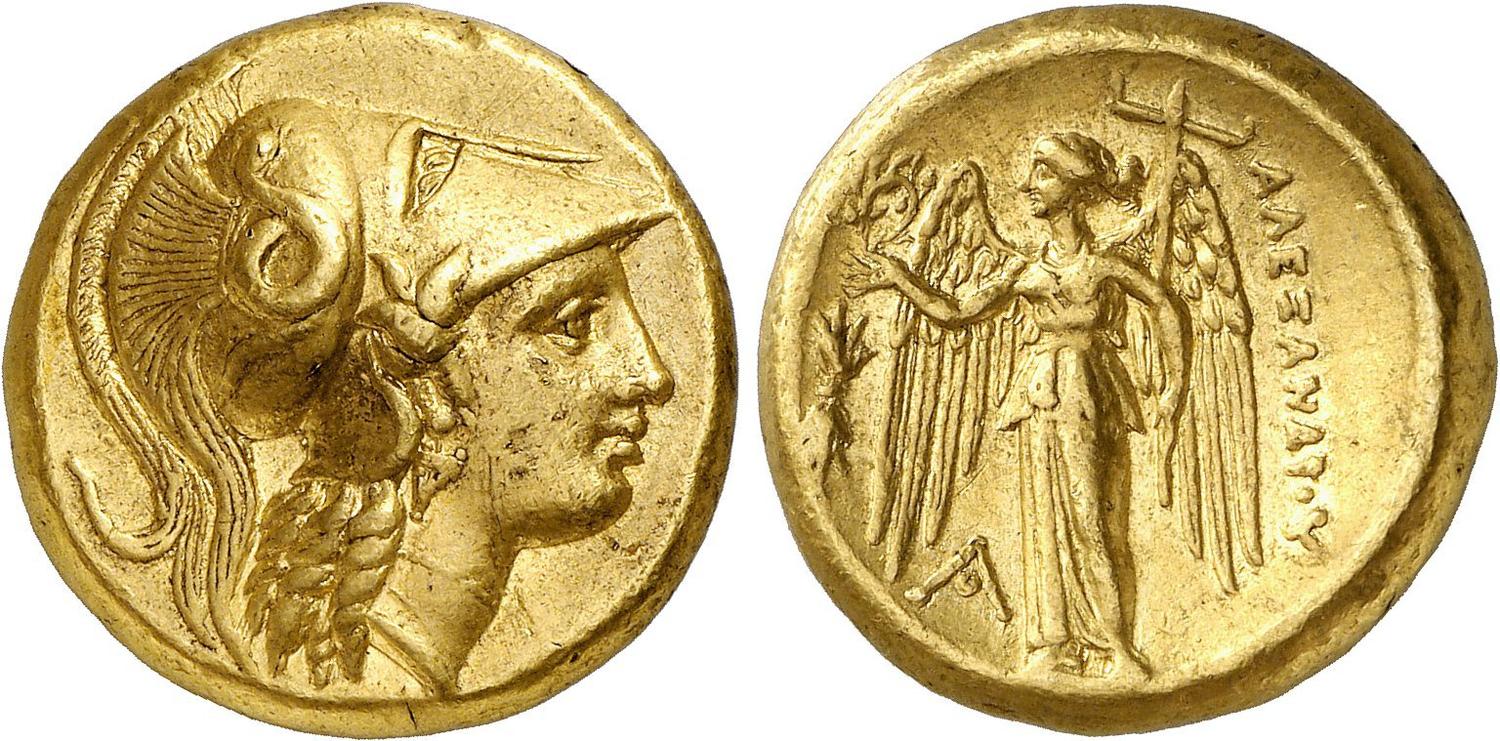H 165 - Aigai (Alexander the Great), gold, distaters (330-318 BCE)
From SILVER
330 BCE - 318 BCE Gold 32,886 kg
Description
| ObverseInscription or printing placed on the obverse.: | Head of Athena right, wearing crested Corinthian helmet with snake. |
| ReverseInscription or printing placed on the reverse.: | AΛΕΞΑΝΔΡΟΥ (Greek).Nike standing to left, holding wreath in outstretched right hand and stylis over left shoulder, thunderbolt to left |
Mint and issuing power
| MintIdentifies the place of manufacture or issue of a numismatic object.: | Aigai | Ancient regionAncient region.: | Macedon | Modern countryModern country: Greece | AuthorityIdentifies the issuing power. The authority can be "pretended" when the name or the portrait of X is on the coin but he/she was not the issuing power. It can also be "uncertain" when there is no mention of X on the coin but he/she was the issuing power according to the historical sources: | Alexander III the Great (Argead king, 336-323 BC) |
Chronology
| FromIdentifies the initial date in a range assigned in a numismatic context. | 330 BCE | toIdentifies the final date in a range assigned in a numismatic context.. | 318 BCE | PeriodTime period of the numismatic object.: Classical and Hellenistic |
Physical description
| MetalThe physical material (usually metal) from which an object is made.: | Gold |
Median weightMedian of the weights of numismatic objects (in grams). in grams | 17.20 | DenominationTerm indicating the value of a numismatic object. Examples: tetradrachm, chalkous, denarius.: | distater |
StandardStandard.: | Attic |
Image

H165 Corinth Alexander distaters.jpg [1]
References
| Die study referencePublication of the study: | E. T. Newell et S. P. Noé1E. T. Newell et S. P. Noé, The Alexander Coinage of Sicyon, NS 6, New York, 1950. | ||
| Coin series referenceReference to coin series study: | RQEMH2RQEMH, n° 165 | ||
Obverse dies distribution
| FrequencyFrequency of specimen in distribution. ᵖ | Number of obversesNumber of obverse dies. ᵖ (o) | % (o) | Number of coinsNumber of coins. (n) | % (n) | Die nameName(s) of the die(s). |
| 1 | 3 | 37.5 | 3 | 10.34 | 9, 10, 11 |
| 2 | 2 | 25 | 4 | 13.79 | 1, 12 |
| 6 | 2 | 25 | 12 | 41.38 | 8, 15 |
| 10 | 1 | 12.5 | 10 | 34.48 | 13 |
| Total | 8 of 8 | 100 | 29 of 29 | 99.99 |
Reverse dies distribution
no distribution is available
Quantification
| Number of obversesNumber of obverse dies. ᵖ (o) | 8 | Number of singletons (o1)The number of singleton coins. ᵖ | 3 |
| Number of reverse diesNumber of reverse dies. (r) | 21 | Number of coinsNumber of coins. (n) | 29 |
| Coins per obverse dieNumber of coins per obverse die. (n/o) | 3.63 | Coins per reverse dieNumber of coins per reverse die. (n/r) | 1.38 |
| Reverse per obverse ratioRatio of obverse dies divided by reverse dies. (r/o) | 2.63 | Percentage of singletons (o1)number of coins (n) divided by the number of singletons (o1) ᵖ | 37.5 % |
| Original number of dies (O) (Carter 1983 formula)The estimation of the number of coins according to Carter 1983 ᵖ | 9.56 | Coins struck if 20,000 as average productivity per dieCoins made if the average productivity for obverses (according to Carter) is 20,000. ᵖ | 191,200 |
| Original number of dies (O) (Esty 2011 formula)The estimation of the number of coins according to the singleton formula in Esty 2011 ᵖ (O) | 11.05 | Survival rate if 20,000 as average productivity per dieSurvival rate if average productivity is 20,000. ᵖ | 0.00015 |
| Coverage (o = % of O) (Esty 1984 formula)Esty 1984 - coverage (% of O) ᵖ (o = % of O) | 89.66% | Die productivity if survival rate 1/2,000Average productivity if survival rate is 1/2,000. ᵖ | 6,066.95 |
| Weight of silver (in kg) if 20,000 coins per die (O = Carter formula)Carter 1983 * Median weight * 20000 (*10 if gold or electrum) ᵖ | 32,886 kg <br /> 32,886 kg | Die productivity if survival rate 1/5,000Average productivity if survival rate is 1/5,000. ᵖ | 15,167.36 |
Remarks
These issues were tentatively attributed to Corinth by Newell and Noe but have been placed in Macedonia by Troxell